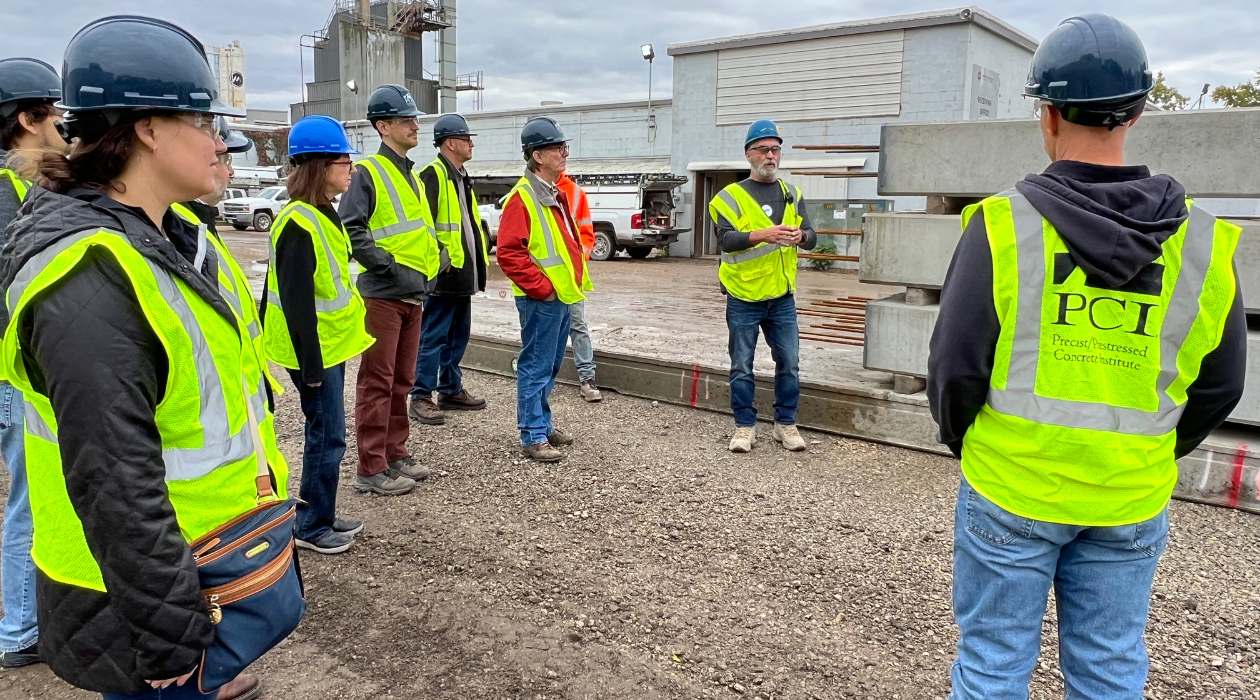Home>diy>Building & Construction>What Is Letting In Construction


Building & Construction
What Is Letting In Construction
Modified: December 8, 2023
Learn about the importance of letting in construction and its role in building construction projects. Discover how letting can impact construction timelines and budgets.
(Many of the links in this article redirect to a specific reviewed product. Your purchase of these products through affiliate links helps to generate commission for Storables.com, at no extra cost. Learn more)
Introduction
Welcome to the world of construction, where projects are built from the ground up, transforming ideas on paper into tangible structures that shape the world we live in. In the construction industry, various processes and methods are involved in bringing these projects to life, and one crucial step in this journey is the process of letting.
Letting in construction refers to the process of inviting bids from contractors for a particular construction project. It is a way for project owners or public agencies to select the most suitable contractor who can fulfill the project requirements based on cost, experience, and expertise. The letting process is crucial in ensuring that construction projects are awarded to capable and qualified contractors.
Throughout this article, we will delve into the definition, purpose, benefits, and the steps involved in the letting process in construction. Understanding these aspects will not only give you insight into the inner workings of the construction industry but also help you navigate the process as a project owner or contractor.
Key Takeaways:
- Letting in construction is a fair and transparent process that allows project owners to select the best contractor for their projects based on expertise, cost, and qualifications, promoting high-quality outcomes and fair competition.
- The letting process involves advertising for bids, receiving and reviewing bids, awarding the contract, and executing the project, emphasizing the importance of clear communication, thorough evaluation, and effective project initiation for successful construction projects.
Read more: What Is Construction
Definition of Letting in Construction
In the world of construction, letting is a term that specifically refers to the process of inviting bids from contractors for a construction project. It is a formal procedure conducted by project owners or public agencies to select a contractor who can complete the project based on specific requirements and criteria.
The letting process typically begins with the owner advertising the project and soliciting bids from interested contractors. This allows contractors to submit proposals and compete for the opportunity to undertake the construction project. The bids received are then evaluated and the project is awarded to the contractor who best meets the project’s requirements, considering factors such as cost, experience, and qualifications.
The letting process serves as a fair and transparent method for selecting a contractor who can deliver the project on time, within budget, and to the desired quality standards. It provides an opportunity for both small and large contractors to participate in the competitive bidding process, promoting a level playing field.
Letting in construction is commonly used in public infrastructure projects, such as roads, bridges, schools, and government buildings. However, it is also practiced in private construction projects, where project owners seek to identify qualified contractors who can meet their specific construction needs.
Purpose and Benefits of Letting in Construction
The letting process plays a critical role in the construction industry, serving several important purposes and providing numerous benefits for both project owners and contractors. Let’s explore some of the key purposes and benefits:
Purpose:
- Selecting the Best Contractor: The primary purpose of letting in construction is to identify and select the most suitable contractor for a specific project. Through the competitive bidding process, project owners can evaluate multiple proposals and choose the contractor with the best combination of expertise, experience, and cost.
- Fair and Transparent Selection: Letting ensures fairness and transparency in choosing a contractor. By establishing a standardized evaluation process, all contractors have an equal opportunity to compete for the project based on their qualifications and capabilities.
- Meeting Project Requirements: Letting helps ensure that construction projects are awarded to contractors who can meet the project’s specific requirements. This includes factors such as timeline, budget, quality standards, and technical specifications.
Benefits:
- Competitive Pricing: The letting process encourages contractors to submit competitive bids, as they strive to offer the best price for the project. This can result in cost savings for the project owner.
- Quality and Expertise: Through the letting process, project owners have the opportunity to evaluate contractors based on their experience, expertise, and qualifications. This ensures that the selected contractor has the necessary skills to deliver a high-quality construction project.
- Enhanced Project Accountability: Letting creates a contractual relationship between the project owner and the selected contractor. This promotes accountability on both sides, as the contractor is bound by the terms of the contract to complete the project as per the agreed-upon specifications.
- Promotes Fair Competition: Letting provides an equal opportunity for contractors of all sizes to compete for a project. This promotes fair competition, allowing small and emerging contractors to showcase their capabilities alongside larger, more established firms.
- Transparency and Public Trust: In public infrastructure projects, letting ensures transparency and accountability, assuring the public that the selection process is unbiased and in the best interest of the community.
Overall, the letting process in construction serves as a mechanism to select competent contractors, achieve value for money, and ensure high-quality construction projects that meet the needs of project owners and the communities they serve.
Read more: How To Let Go Of Things And Declutter
Letting Process in Construction
The letting process in construction consists of several distinct steps that are followed to select the most qualified contractor for a specific project. While the exact process may vary depending on the project and the contracting entity, the general steps involved are as follows:
Advertising for Bids:
The process begins with the project owner or public agency advertising the project and inviting contractors to submit bids. This advertisement typically includes project details, specifications, and any special requirements.
Receiving and Reviewing Bids:
Contractors interested in the project will submit their bids, which typically include proposed costs, schedules, project plans, and relevant documents. The project owner then reviews and evaluates the submitted bids to ensure they meet the project’s requirements and specifications.
Evaluating Contractors:
During this stage, the project owner evaluates the contractors based on various criteria, including their experience, qualifications, financial stability, and past performance. This assessment helps in determining which contractors are the most suitable for the project.
Read more: How Long To Let Novaform Mattress Expand
Comparing and Analyzing Bids:
Once the bids have been reviewed, the project owner compares and analyzes the bids based on factors such as cost, quality, schedule, and proposed methodologies. This analysis helps in identifying the most competitive and feasible bids.
Awarding the Contract:
After careful evaluation and analysis, the project owner awards the contract to the contractor who has submitted the most competitive bid and best meets the project requirements. The contract is typically awarded based on a combination of factors, including price, quality, and the contractor’s ability to perform the work.
Contract Execution and Project Initiation:
Once the contract is awarded, the project owner and the selected contractor execute the necessary legal documentation to formalize the agreement. This includes signing the contract, outlining the project’s scope, deliverables, timelines, and other relevant terms and conditions. After the execution of the contract, the construction project can officially commence.
Throughout the letting process, open communication between the project owner and the contractors is crucial. This ensures that all parties involved are clear on project requirements, deadlines, and any other relevant details. It also allows for clarifications, negotiations, and the establishment of a strong working relationship between the project owner and the selected contractor.
It is important to note that the letting process is a complex and detailed procedure, requiring expertise and careful consideration. Project owners often engage professionals such as architects, engineers, and procurement specialists to assist in the evaluation and selection process. This helps ensure that the most qualified contractors are chosen for the successful execution of construction projects.
Advertising for Bids
Advertising for bids is an essential step in the letting process of construction projects. It involves the project owner or public agency actively soliciting bids from contractors who are interested in undertaking the construction project. The goal of advertising for bids is to attract qualified contractors who can provide competitive proposals to fulfill the project requirements. Let’s dive deeper into the key aspects of advertising for bids:
Read more: How Long To Let A Box Mattress Expand
Project Advertisement:
The project owner or public agency prepares a detailed advertisement that provides information about the project. This advertisement includes essential details such as project scope, specifications, contractual terms, and any specific requirements that contractors must meet. The project advertisement is typically published in various media platforms, such as newspapers, trade publications, and industry-specific websites. It may also be posted on the project owner’s website and distributed through networking channels in the construction industry.
Invitation to Bid:
The advertisement serves as an invitation to contractors to submit their bids for the project. It outlines the process and timeline for bidding, including the deadline for bid submission. Contractors who are interested in participating in the bidding process review the project advertisement and assess whether they have the capability and capacity to successfully complete the project. If interested, contractors prepare their bids and submit them according to the instructions provided in the advertisement.
Pre-Bid Meetings and Site Visits:
In some cases, project owners may schedule pre-bid meetings or site visits to provide potential bidders with an opportunity to ask questions and gather additional information about the project. These meetings allow contractors to gain a better understanding of the project requirements and scope, as well as to assess the site conditions. Pre-bid meetings and site visits promote transparency, clarity, and fairness in the letting process and help contractors submit more accurate and informed bids.
Bid Documents:
As part of the advertising process, project owners typically provide bid documents to interested contractors. These documents include comprehensive project information, such as drawings, plans, specifications, contract forms, and any other relevant documents. Bid documents allow contractors to thoroughly understand the project requirements and prepare their bids with accuracy. It is essential for contractors to carefully review the bid documents to ensure they have a complete understanding of the project and can accurately price their services.
Read more: How Long To Let Pumpkin Seeds Dry
Promotion of Fair Competition:
Advertising for bids promotes fair competition in the construction industry. By actively seeking bids from a wide range of contractors, project owners ensure that all qualified contractors have an equal opportunity to participate in the bidding process. This promotes a competitive environment where contractors can showcase their skills, expertise, and competitive pricing. Fair competition fosters innovation, quality, and cost-effectiveness in the bidding process, ultimately leading to the selection of the most qualified contractor for the project.
Advertising for bids is a crucial step in the letting process, enabling project owners to attract a pool of qualified contractors and receive competitive proposals. It sets the foundation for a fair and transparent bidding process, ensuring that the construction project is awarded to a contractor who can meet the project requirements and deliver successful outcomes.
Receiving and Reviewing Bids
Once the bidding period for a construction project has ended, the project owner or their designated representatives begin the process of receiving and reviewing the submitted bids. This step is crucial as it involves the careful evaluation and assessment of each bid to determine which contractors meet the project’s requirements. Let’s explore the key aspects of receiving and reviewing bids:
Bid Opening:
After the bidding period has concluded, the project owner organizes a bid opening session. During this session, the bids are publicly opened and read aloud to ensure transparency. This process allows all stakeholders, including the contractors who submitted bids, to be aware of the bids received and their respective prices. The bid opening is typically attended by project owners, procurement officers, and other relevant parties.
Bid Evaluation Criteria:
Prior to receiving the bids, the project owner establishes a set of evaluation criteria to assess the bids effectively. These criteria may include factors such as cost, expertise, experience, project schedule, proposed methodologies, and compliance with project specifications. The evaluation criteria ensure a comprehensive and fair assessment of the bids based on the project’s specific needs.
Read more: What Is Retrofit In Construction
Compliance Check:
Upon receiving the bids, the project owner or their representatives conduct a thorough compliance check to ensure that all submitted bids meet the necessary requirements. This includes verifying that the required bid documents and forms have been provided and that the bids are complete and accurate. Any bids that do not comply with the specified requirements may be deemed non-responsive and eliminated from further consideration.
Bid Evaluation:
Once all bids have passed the compliance check, the project owner proceeds with the evaluation process. This involves a careful assessment of each bid, comparing them against the established evaluation criteria. The evaluation may involve a team of experts, including procurement officers, engineers, architects, and other relevant professionals, who collectively evaluate the bids to determine their suitability.
Price vs. Qualifications:
One critical aspect of bid evaluation is balancing price and qualifications. While cost is an important factor, it should not be the sole determiner of selecting a contractor. The project owner considers the overall value offered by each bid, considering the contractor’s qualifications, expertise, experience, and proposed project approach. This ensures that the chosen contractor can deliver the project to the required quality standards and within the specified timelines.
Bid Clarification and Negotiation:
During the bid evaluation process, there might be instances where the project owner seeks clarification or additional information from the bidders. This can involve seeking further details on the proposed construction methods, materials, or other aspects. In some cases, negotiations may occur to refine the terms and conditions of the bid. These clarifications and negotiations are necessary to ensure that the project owner has a clear understanding of each bid and to address any outstanding concerns or doubts.
Read more: What Is Stucco In Construction
Selection of Winning Bid:
After careful evaluation, negotiations, and clarification, the project owner selects the winning bid. This is typically the bid that best meets the project requirements, offers the best value, and aligns with the project owner’s objectives. The selected contractor is then notified, and the process of contract execution and project initiation begins.
The process of receiving and reviewing bids is a critical phase in the letting process, enabling project owners to identify the most suitable contractor for their construction project. Thorough evaluation, compliance checks, and consideration of both price and qualifications ensure the selection of a contractor who can successfully deliver the project to the intended standards.
Awarding the Contract
After the thorough evaluation of bids and selecting the winning bid, the next crucial step in the letting process of construction projects is the awarding of the contract. This step involves finalizing the agreement between the project owner and the selected contractor, formalizing the terms and conditions of the project. Let’s explore the key aspects of awarding the contract:
Contract Preparation:
Once the winning bid has been chosen, the project owner or their legal representative prepares the contract documents. The contract outlines the scope of work, project timeline, deliverables, payment terms, and any other relevant contractual obligations. The project owner ensures that the contract aligns with the project’s requirements and that it protects both parties’ interests.
Negotiation and Clarification:
In some cases, before the contract is finalized, there may be a negotiation phase. This phase involves discussions between the project owner and the selected contractor to clarify any outstanding issues, adjust terms if required, or address any concerns. The negotiation phase ensures that both parties have a clear understanding of the contract and are in mutual agreement before signing.
Read more: What Is Siding In Construction
Contract Execution:
Once the contract has been prepared and any negotiations or clarifications have been made, the project owner and the selected contractor execute the contract. This involves signing the document to make it legally binding for both parties. The contract execution marks the formal acceptance of the terms and conditions and establishes the contractual relationship between the project owner and the contractor.
Contractual Obligations:
With the contract in place, both the project owner and the contractor are bound by the agreed-upon obligations. The project owner is responsible for providing necessary project information, access to the site, and making timely payments as outlined in the contract. The contractor is accountable for completing the project as per the specifications, meeting the project timeline, and ensuring the necessary quality standards are adhered to.
Project Kick-off:
After the contract has been executed, the project owner and the contractor typically hold a project kick-off meeting. This meeting allows both parties to review the project details, discuss project-specific requirements, establish lines of communication, and develop an overall understanding of the project’s execution plan. The kick-off meeting sets the stage for successful project initiation and sets the tone for effective collaboration between the project owner and the contractor throughout the construction process.
Awarding the contract is a significant milestone in the letting process as it formally sets the project into motion. Careful attention to contract preparation, negotiation, and execution ensures a clear understanding of project expectations and minimizes future disputes. By awarding the contract to the selected contractor, the project owner establishes a strong partnership and lays the foundation for a successful construction project.
Contract Execution and Project Initiation
Once the contract has been awarded, the construction project enters the phase of contract execution and project initiation. This pivotal stage marks the official start of the project and involves various activities to set the project in motion. Let’s explore the key aspects of contract execution and project initiation:
Read more: What Is A Surcharge In Construction
Contractual Documentation:
After the contract has been awarded, both the project owner and the contractor complete the necessary contractual documentation. This includes signing the contract and other related agreements, such as bonds, insurance policies, and permits. This documentation serves as proof of the agreement between the parties and establishes the legal framework for the project.
Mobilization:
Mobilization is the process of preparing the necessary resources and mobilizing the construction team and equipment required for the project. The contractor begins assembling the project team, including site supervisors, engineers, and skilled workers. They also arrange for the delivery of required materials, tools, and equipment to the construction site. Mobilization ensures that all essential resources are ready and available to start the construction activities.
Establishing Project Communication:
Effective communication is crucial for the success of any construction project. During the project initiation phase, the project owner and the contractor establish clear lines of communication. This involves identifying key project representatives, setting up regular progress meetings, and determining preferred communication channels for exchanging project-related information. Effective communication ensures transparency, clarity, and facilitates problem-solving throughout the project duration.
Project Planning:
Once the project is initiated, detailed project planning takes place. This includes developing a comprehensive project schedule that outlines the various construction activities and their timelines. Additionally, the contractor prepares a project budget, considering the estimated costs for labor, materials, equipment, and any other project-related expenses. Project planning helps in effectively managing resources and ensures that the project progresses according to the desired timeline and budget.
Read more: What Is Rigging In Construction
Site Mobilization and Preparation:
Before construction activities begin, the construction site needs to be properly prepared. This involves site mobilization, including setting up temporary facilities such as site offices, storage areas, and necessary amenities for the construction team. The site is organized and marked for construction activities, ensuring safety protocols are in place, and securing any necessary permits or licenses are obtained.
Execution of Construction Activities:
With the project documentation completed and the site prepared, the construction activities can commence. The contractor follows the agreed-upon project plan, executing the construction activities in line with the project specifications. This includes activities such as excavation, foundation construction, structural work, installation of utilities, and various other construction tasks. The project owner may conduct periodic inspections to ensure that the work is progressing as per contractual requirements.
Monitoring Progress and Quality:
Throughout the project execution phase, both the project owner and the contractor monitor the progress and quality of the construction activities. Regular site visits, progress meetings, and inspections are conducted to assess the project’s adherence to the agreed-upon timeline, quality standards, and specifications. Any necessary adjustments or corrective actions are taken to ensure that the construction project stays on track.
Contract execution and project initiation set the stage for the successful implementation of the construction project. By completing the necessary contractual documentation, mobilizing resources, establishing project communication, and executing construction activities, the project moves forward towards completion. Effective management and coordination during this phase contribute to the overall success of the construction project.
Conclusion
The process of letting in construction plays a crucial role in the successful execution of construction projects. By inviting bids from qualified contractors, project owners can select the most suitable and capable contractor to bring their vision to life. Throughout this article, we have explored the definition, purpose, and benefits of letting in construction, as well as the steps involved in the letting process.
Advertising for bids allows project owners to attract a diverse pool of contractors and promote fair competition. It ensures transparency in the selection process and enables contractors to submit competitive proposals based on their expertise, experience, and cost. Receiving and reviewing bids involves careful evaluation of submitted proposals, considering factors such as compliance with project requirements, price competitiveness, and overall qualifications. The process of awarding the contract formalizes the agreement between the project owner and the selected contractor, establishing the groundwork for a successful project partnership.
Contract execution and project initiation mark the official start of the construction project. Mobilizing resources, establishing communication channels, and planning the project activities are essential components of this phase. The execution of construction activities, along with thorough monitoring of progress and quality, ensures that the project stays on track and meets the desired objectives.
Throughout the letting process and the subsequent project execution, open communication, collaboration, and adherence to contractual obligations are crucial. This fosters a productive relationship between the project owner and the chosen contractor, leading to successful outcomes.
In conclusion, letting in construction acts as a gateway to finding the right contractor for a construction project. It promotes fair competition, ensures transparency, and allows project owners to select the most competent contractor. By following the steps outlined in the letting process, project owners can embark on a successful construction journey, resulting in high-quality projects that meet their requirements and contribute to the development of our built environment.
Frequently Asked Questions about What Is Letting In Construction
Was this page helpful?
At Storables.com, we guarantee accurate and reliable information. Our content, validated by Expert Board Contributors, is crafted following stringent Editorial Policies. We're committed to providing you with well-researched, expert-backed insights for all your informational needs.







0 thoughts on “What Is Letting In Construction”